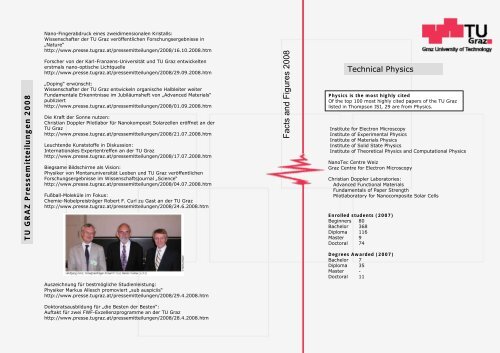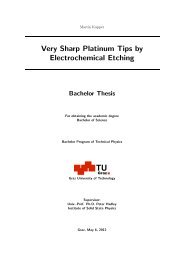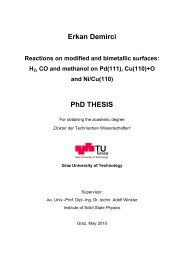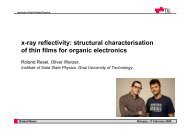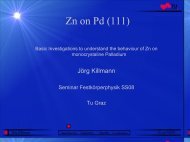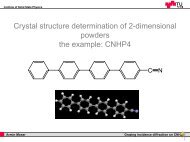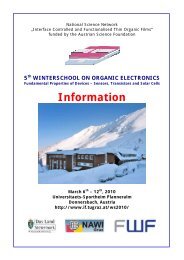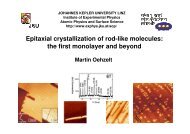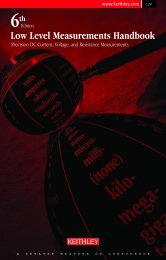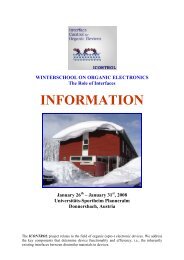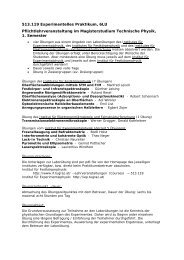Facts and Figures 2008 - Institute of Solid State Physics - Graz ...
Facts and Figures 2008 - Institute of Solid State Physics - Graz ...
Facts and Figures 2008 - Institute of Solid State Physics - Graz ...
Create successful ePaper yourself
Turn your PDF publications into a flip-book with our unique Google optimized e-Paper software.
TU GRAZ Pressemitteilungen <strong>2008</strong><br />
Nano-Fingerabdruck eines zweidimensionalen Kristalls:<br />
Wissenschafter der TU <strong>Graz</strong> veröffentlichen Forschungsergebnisse in<br />
„Nature“<br />
http://www.presse.tugraz.at/pressemitteilungen/<strong>2008</strong>/16.10.<strong>2008</strong>.htm<br />
Forscher von der Karl-Franzens-Universität und TU <strong>Graz</strong> entwickelten<br />
erstmals nano-optische Lichtquelle<br />
http://www.presse.tugraz.at/pressemitteilungen/<strong>2008</strong>/29.09.<strong>2008</strong>.htm<br />
„Doping“ erwünscht:<br />
Wissenschafter der TU <strong>Graz</strong> entwickeln organische Halbleiter weiter<br />
Fundamentale Erkenntnisse im Jubiläumsheft von „Advanced Materials“<br />
publiziert<br />
http://www.presse.tugraz.at/pressemitteilungen/<strong>2008</strong>/01.09.<strong>2008</strong>.htm<br />
Die Kraft der Sonne nutzen:<br />
Christian Doppler Pilotlabor für Nanokomposit Solarzellen eröffnet an der<br />
TU <strong>Graz</strong><br />
http://www.presse.tugraz.at/pressemitteilungen/<strong>2008</strong>/21.07.<strong>2008</strong>.htm<br />
Leuchtende Kunstst<strong>of</strong>fe in Diskussion:<br />
Internationales Expertentreffen an der TU <strong>Graz</strong><br />
http://www.presse.tugraz.at/pressemitteilungen/<strong>2008</strong>/17.07.<strong>2008</strong>.htm<br />
Biegsame Bildschirme als Vision:<br />
Physiker von Montanuniversität Leoben und TU <strong>Graz</strong> veröffentlichen<br />
Forschungsergebnisse im Wissenschaftsjournal „Science“<br />
http://www.presse.tugraz.at/pressemitteilungen/<strong>2008</strong>/04.07.<strong>2008</strong>.htm<br />
Fußball-Moleküle im Fokus:<br />
Chemie-Nobelpreisträger Robert F. Curl zu Gast an der TU <strong>Graz</strong><br />
http://www.presse.tugraz.at/pressemitteilungen/<strong>2008</strong>/24.6.<strong>2008</strong>.htm<br />
<strong>Facts</strong> <strong>and</strong> <strong>Figures</strong> <strong>2008</strong><br />
Technical <strong>Physics</strong><br />
<strong>Physics</strong> is the most highly cited<br />
Of the top 100 most highly cited papers <strong>of</strong> the TU <strong>Graz</strong><br />
listed in Thompson ISI, 29 are from <strong>Physics</strong>.<br />
<strong>Institute</strong> for Electron Microscopy<br />
<strong>Institute</strong> <strong>of</strong> Experimental <strong>Physics</strong><br />
<strong>Institute</strong> <strong>of</strong> Materials <strong>Physics</strong><br />
<strong>Institute</strong> <strong>of</strong> <strong>Solid</strong> <strong>State</strong> <strong>Physics</strong><br />
<strong>Institute</strong> <strong>of</strong> Theoretical <strong>Physics</strong> <strong>and</strong> Computational <strong>Physics</strong><br />
NanoTec Centre Weiz<br />
<strong>Graz</strong> Centre for Electron Microscopy<br />
Christian Doppler Laboratories:<br />
Advanced Functional Materials<br />
Fundamentals <strong>of</strong> Paper Strength<br />
Pilotlaboratory for Nanocomposite Solar Cells<br />
Enrolled students (2007)<br />
Beginners 80<br />
Bachelor 368<br />
Diploma 116<br />
Master 9<br />
Doctoral 74<br />
Degrees Awarded (2007)<br />
Bachelor 7<br />
Diploma 35<br />
Master -<br />
Doctoral 11<br />
Auszeichnung für bestmögliche Studienleistung:<br />
Physiker Markus Allesch promoviert „sub auspiciis“<br />
http://www.presse.tugraz.at/pressemitteilungen/<strong>2008</strong>/29.4.<strong>2008</strong>.htm<br />
Doktoratsausbildung für „die Besten der Besten“:<br />
Auftakt für zwei FWF-Exzellenzprogramme an der TU <strong>Graz</strong><br />
http://www.presse.tugraz.at/pressemitteilungen/<strong>2008</strong>/28.4.<strong>2008</strong>.htm
<strong>Institute</strong> for Electron Microscopy <strong>and</strong> Fine Structure Research (FELMI)<br />
FELMI has several <strong>of</strong> Europe‘s most advanced electron microscopes. It plays a<br />
primary role to support interdisciplinary <strong>and</strong> interfacultary research, training<br />
<strong>and</strong> education through essential resources for electron- <strong>and</strong> ion beam micro<strong>and</strong><br />
nanocharacterisation <strong>of</strong> all kind <strong>of</strong> advanced materials.<br />
http://www.felmi-zfe.tugraz.at/<br />
<strong>Institute</strong> <strong>of</strong> Experimental <strong>Physics</strong><br />
Research areas at the <strong>Institute</strong> <strong>of</strong> Experimental <strong>Physics</strong> include studies <strong>of</strong> free<br />
atoms, molecules, <strong>and</strong> clusters using high resolution laser spectroscopy <strong>and</strong><br />
ionization methods, <strong>and</strong> surface scattering as well as nonlinear optics, plasma<br />
diagnostics <strong>and</strong> high temperature materials characterization.<br />
http://iep.tugraz.at<br />
International Conferences<br />
July 21 - 25, <strong>2008</strong> in <strong>Graz</strong> / Austria<br />
<strong>Institute</strong> <strong>of</strong> Materials <strong>Physics</strong><br />
The <strong>Institute</strong> <strong>of</strong> Materials <strong>Physics</strong> at <strong>Graz</strong> University <strong>of</strong> Technology is working<br />
on basic <strong>and</strong> applied materials research with a major focus on nanostructured<br />
functional materials, defects in solids, <strong>and</strong> health issues <strong>of</strong> radiation physics.<br />
http://www.imp.tugraz.at/<br />
<strong>Institute</strong> <strong>of</strong> <strong>Solid</strong> <strong>State</strong> <strong>Physics</strong><br />
The <strong>Institute</strong> <strong>of</strong> <strong>Solid</strong> <strong>State</strong> <strong>Physics</strong> focuses on surface science <strong>and</strong> organic<br />
electronic materials <strong>and</strong> devices. It participates in two Christian Doppler<br />
Laboratories: Fundamentals <strong>of</strong> Paper Strength, <strong>and</strong> Pilot laboratory for<br />
Nanocomposite Solar Cells.<br />
http://www.if.tugraz.at/<br />
<strong>Institute</strong> <strong>of</strong> Theoretical <strong>and</strong> Computational <strong>Physics</strong><br />
The research activities <strong>of</strong> the ITPCP focus on many-body systems in solidstate<br />
<strong>and</strong> plasma physics. Research topics range from weak to strong<br />
correlation effects, such as b<strong>and</strong> structures, magnetism, spintronics, hightemperature<br />
superconductivity, colossal magneto-resistance, plasma<br />
confinement, heating in thermonuclear fusion devices, <strong>and</strong> transport in nanomaterials.<br />
http://itp.tugraz.at/<br />
1500 k€ Industrial contracts in <strong>2008</strong><br />
The physics institutes have contracts with about 100 companies. Most <strong>of</strong><br />
these contacts are through NTC Weiz, Zentrum für Elektronenmikroskopie,<br />
<strong>and</strong> the Christian Doppler laboratories.<br />
- Anton Paar / <strong>Graz</strong><br />
- AT&S AG / Stmk.<br />
- AVL List GmbH / Stmk.<br />
- BRIMATECH Services GmbH / Wien<br />
- Durst Phototechnik Digital Technology GmbH / Lienz<br />
-HiTec Marketing / Wien<br />
-Infineon / Munich<br />
- Isovolta AG / Stmk.<br />
- Mayr-Melnh<strong>of</strong> Karton Gesellschaft mbH / Stmk.<br />
- Mondi Packaging / Stmk<br />
- Sappi Austria Produktions-GmbH & Co. KG / Stmk.<br />
- SEZ, Villach
Prizes <strong>2008</strong><br />
NAWI<br />
Based on a long-st<strong>and</strong>ing well-established cooperation, the <strong>Physics</strong><br />
<strong>Institute</strong>s <strong>of</strong> <strong>Graz</strong> University <strong>of</strong> Technology <strong>and</strong> Karl-Franzens University<br />
<strong>Graz</strong> are active members <strong>of</strong> NAWI <strong>Graz</strong>.<br />
The TU <strong>Graz</strong> has the highest ranked physics department for<br />
teaching in Austria in the <strong>2008</strong> Centre for Higher Education<br />
Development (CHE) rankings.<br />
Graduate <strong>and</strong> post-graduate teaching:<br />
Joint <strong>Graz</strong> <strong>Physics</strong> Colloquium running for more than 8 years.<br />
Joint Doctoral School <strong>of</strong> <strong>Physics</strong> <strong>of</strong> TUG <strong>and</strong> KFUG (started <strong>2008</strong>).<br />
FWF Doktoratskolleg - Numerical Simulations in Technical Sciences<br />
FWF Doktoratskolleg - Hadrons in Vacuum, Nuclei <strong>and</strong> Stars<br />
New NAWI Master‘s program Nanophysics starting 2009.<br />
Undergraduate teaching:<br />
Research:<br />
In the bachelor‘s programmes Technical <strong>Physics</strong> (TUG) <strong>and</strong> <strong>Physics</strong><br />
(KFUG) about 30% <strong>of</strong> the courses are <strong>of</strong>fered on a joint basis (starting<br />
2009).<br />
Partners from the <strong>Physics</strong> <strong>Institute</strong>s <strong>of</strong> <strong>Graz</strong> University <strong>of</strong> Technology<br />
<strong>and</strong> Karl Franzens University <strong>Graz</strong> are closely cooperating in the<br />
following externally funded projects:<br />
Peter Pacher <strong>and</strong> Daniel Koller (KFU) shared the <strong>2008</strong> ESG-<br />
Nano-Prize awarded by the Erwin Schrödinger Society for<br />
Nanoscience.<br />
Evelin Fisslthaler won the <strong>2008</strong> Nano Youth Award <strong>of</strong> the<br />
Austrian Federal Ministry <strong>of</strong> Transport, Innovation <strong>and</strong><br />
Technology. The award is given for excellent research in the<br />
field <strong>of</strong> nanoscience <strong>and</strong> nanotechnology.<br />
Pr<strong>of</strong>. Emil List won the award for the best project<br />
development at the 4th Global Plastic Electronics Conference<br />
on October 28, <strong>2008</strong> in Berlin. The award cited his work on<br />
organic optoelectronics <strong>and</strong> sensors.<br />
Lorenz Romaner won the Karlheinz Seeger prize <strong>of</strong> the<br />
Austrian Physical Society for best solid state physics thesis in<br />
Austria.<br />
National Research Network (NFN):<br />
Interface Control <strong>and</strong> Functionalised Organic Films<br />
(participating NAWI <strong>Physics</strong> groups: M. Ramsey, KFUG; R. Resel, A.<br />
Winkler, E. Zojer, TUG)<br />
National Research Network (NFN):<br />
High-performance bulk nanocrystalline materials<br />
(participating NAWI <strong>Physics</strong> groups: H. Krenn, KFUG; R. Würschum,<br />
TUG)<br />
Wolfram Steurer was awarded a DOC stipend <strong>of</strong> the Austrian<br />
Academy <strong>of</strong> Sciences<br />
Markus Allesch received his doctorate „sub auspiciis<br />
praesidentis“<br />
Markus Allesch also received the Styrian Youth Prize for<br />
Simulation <strong>and</strong> Modeling.<br />
Austrian Nano-Initiative (FFG) Integrated Organic Sensor <strong>and</strong><br />
Optolectronic Technologies (ISOTEC )<br />
(participating NAWI <strong>Physics</strong> groups: E. List, R. Resel, TUG; J. Krenn ,<br />
KFUG)
Highlights <strong>2008</strong><br />
In the July 3, <strong>2008</strong> issue <strong>of</strong> Science magazine, a<br />
team from the Montan University <strong>and</strong> the TU <strong>Graz</strong><br />
described the special thin film growth<br />
mechanisms related to the flexibility <strong>of</strong> long<br />
molecules.<br />
G. Hlawacek, P. Puschnig, P. Frank, A. Winkler, C.<br />
Ambrosch-Draxl, C. Teichert, 'Characterization <strong>of</strong><br />
Step-Edge Barriers in Organic Thin-Film Growth,'<br />
Science 321 p. 108 (<strong>2008</strong>).<br />
An image <strong>of</strong> an organic transistor made at the<br />
<strong>Institute</strong> <strong>of</strong> <strong>Solid</strong> <strong>State</strong> <strong>Physics</strong>, TU <strong>Graz</strong> appears<br />
on the inside cover <strong>of</strong> the July 7 issue <strong>of</strong><br />
Advanced Materials. The image background<br />
shows an elemental map <strong>of</strong> a cross-section<br />
through an organic thin-film transistor containing<br />
a chemically reactive interfacial layer, as<br />
determined by energy-filtered transmission<br />
electron microscopy.<br />
P. Pacher, A. Lex, V. Proschek, H. Etschmaier, E.<br />
Tchernychova, M. Sezen, U. Scherf, W. Grogger,<br />
G. Trimmel, C. Slugovc, <strong>and</strong> E. Zojer, Chemical<br />
Control <strong>of</strong> Local Doping in Organic Thin-Film<br />
Transistors: From Depletion to Enhancement,<br />
Advanced Materials 20 pp. 3143–3148 (<strong>2008</strong>).<br />
A research team from The Netherl<strong>and</strong>s, Austria, Russia, <strong>and</strong> Germany<br />
announced a breakthrough in the development <strong>of</strong> organic electronic<br />
integrated circuits in the October 16, <strong>2008</strong> issue <strong>of</strong> the journal Nature. Self-<br />
Assembled Monolayer Field Effect Transistors (SAMFETs) were used to build<br />
circuits including a 15-bit code generator consisting <strong>of</strong> over 300 transistors.<br />
nature photonics<br />
Plasmonics is a rapidly developing field that uses plasma waves at an<br />
interface to modify light signals. I team from the TU <strong>Graz</strong> <strong>and</strong> the<br />
University <strong>of</strong> <strong>Graz</strong> used a organic light emitting diode to couple light into a<br />
surface plasmon structure. This has tremendous potential for the<br />
development <strong>of</strong> optically based chemical sensors.<br />
D.M. Koller, A. Hohenau, H. Ditlbacher, N. Galler, F. Reil, F.R. Aussenegg,<br />
A. Leitner, E.J.W. List und J.R. Krenn, Nature Photonics (<strong>2008</strong>)<br />
Cover page <strong>of</strong> the International Journal <strong>of</strong> Materials<br />
Research:<br />
In Cr steels, nitrides (MX, M 2<br />
X) <strong>and</strong> modified Z-phase are <strong>of</strong><br />
special interest because <strong>of</strong> their different contribution to the<br />
creep strength <strong>of</strong> the material. The changes in the chemical<br />
composition <strong>of</strong> complex nitrides <strong>and</strong> their crystallography<br />
were investigated using transmission electron microscopy<br />
<strong>and</strong> electron energy-loss spectrometry.<br />
International Journal <strong>of</strong> Materials Science<br />
Vol. 99 Issue 4 Page 422 April <strong>2008</strong><br />
Cover page <strong>of</strong> the Journal <strong>of</strong> Microscopy:<br />
The first 2 D image obtained using neutral helium atoms<br />
to image a sample.The imaged sample is a hexagonal<br />
copper grating with a period <strong>of</strong> 36 μm <strong>and</strong> a rod thickness<br />
<strong>of</strong> 8 μm. The image is obtained in transmission mode by<br />
scanning the focussed beam across the sample.<br />
Compositional characterisation <strong>and</strong> thermodynamic modelling <strong>of</strong> nitride precipitates<br />
in a 9 – 12% Cr steel<br />
M. ALBU, F. MÉNDEZ MARTÍN, G. KOTHLEITNER, B. SONDEREGGER


